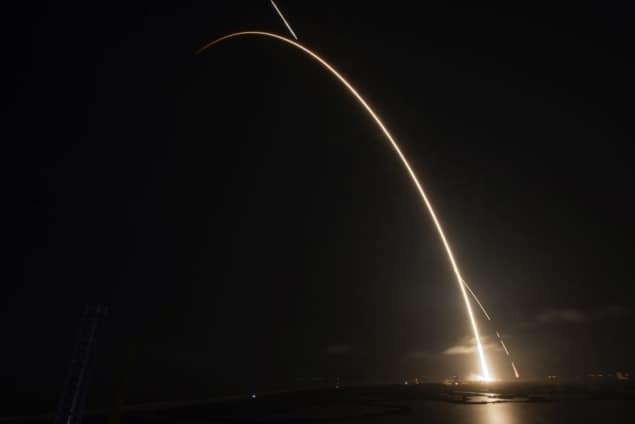
The United Arab Emirates’ (UAE) first lunar rover successfully took off today from Florida’s Cape Canaveral Space Force Station. The UAE rover was launched aboard a SpaceX Falcon 9 rocket at 02:38 local time as part of a UAE–Japan mission to the Moon. If successful, the rover will make the UAE the fourth nation, after China, Russia and the US to operate a spacecraft on the Moon.
The UAE-Japan mission comprises of a lander that is built by Japanese company ispace and called Hakuto-R (meaning “white rabbit”). The craft will take almost four months to reach the Moon before landing in the Atlas crater on the Moon’s nearside. It will then gently release the 10 kg, four-wheel Rashid (meaning “rightly guided”) rover to explore the lunar surface.
The rover – built by the Mohammed bin Rashid Space Centre – contains a high-resolution camera and a thermal-imaging camera that will both study the composition of the lunar regolith. They will also photograph dust movement above the surface, carry out basic examination of lunar rocks as well as study surface plasma conditions.
One intriguing aspect of the rover is that it will test a variety of different materials that could be used to build lunar wheels. The materials are attached as adhesive strips to Rashid’s wheels to determine which ones offer the best protection against lunar dust and other harsh conditions. One such material is a graphene-based composite that was devised by the University of Cambridge, UK, and Belgium’s Université Libre de Bruxelles.
‘Cradle of planetary science’
The UAE–Japan mission represents just one a series of visits to the Moon now under way or planned. In August, South Korea launched an orbiter named Danuri (meaning “enjoy the Moon”). In November, NASA launched its Artemis rocket, carrying the Orion capsule that will eventually take astronauts back to the Moon. Meanwhile, India, Russia and Japan plan to launch uncrewed landers in the first quarter of 2023.
Promoters of planetary exploration see the Moon as the natural take-off location for crewed missions to Mars and perhaps beyond. It is hoped that scientific studies could indicate whether lunar colonies can be self-supporting and lunar resources can provide fuel for those missions. Another possibility has potential appeal on Earth. Planetary geologists believe that the lunar soil contains large amounts of helium-3, an isotope with promise for nuclear fusion. United Arab Emirates’ Hope probe enters Martian orbit
“The Moon is a cradle of planetary science,” says planetary geologist David Blewett of Johns Hopkins University’s Applied Physics Laboratory. “We can study what’s on the Moon that has been erased on Earth because of its active surface.”
The latest mission also shows that commercial companies are beginning to launch their own missions rather than act as government contractors. “Companies, including many that are not in aerospace, are starting to show their interest,” he adds.



